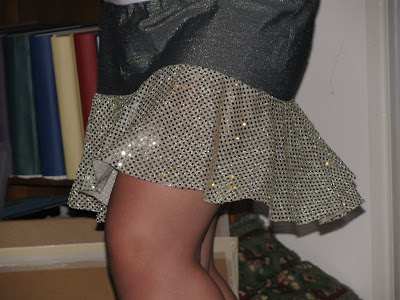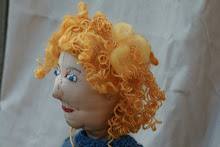No, not a comment on my mental state, or at least, not
before the machine started playing up!
My task for the day was to finish off the quilt for the Neighbourhood House class and I was pretty well on track until
this happened. . .
Here's the stitching from the topside:

. . . it almost looks ok, except it's a bit loose and wobbly looking--as if nothing is really holding it together.
And here it is from the underside:

. . . a disaster of loose, loopy threads that really
aren't holding anything together.
I have enough experience to know that loose stitching like this is usually a tension problem. The tension is the mechanism that holds the threads taut as they are formed so that there is a good balance between the top thread and the bottom thread. Obviously that balance was well and truly
unbalanced. The fact that the extra loopiness is on the underside means that the top tension is too low. The threads are being pulled through to the underside and instead of locking in with the bobbin thread to make stitches they're making these loopy snarls.
Here's how I tried to fix it
- checked to make sure I hadn't accidentally bumped the tension dial
- un-threaded and re-threaded the machine, including the bobbin
- pulled out the bobbin, cleaned under and around the bobbin case with a lint brush
- tried adjusting the tension--the thread was pulling through to the underside, so I tried increasing the top tension--it had no effect. Not a good sign.
- tried a different thread
- and a different bobbin
- adjusted the stitch length
- took a break, had a bowl of icecream, tried it all again
No good!
I rang my sewing machine mechanic, preparing myself for the inconvenience and expense of a repair job, but hoping he could give me some tips over the phone . . .
I LOVE MY SEWING MACHINE MECHANIC! He took me through a step by step check over the phone. Turns out there was a bit of broken thread caught between the tension discs. He told me how to gently drag it out with a pin. Now my sewing machine is happy again--and so am I:)
 Black sequinned, lycra, multicoloured glossy synthetic bling on a bolt.
Black sequinned, lycra, multicoloured glossy synthetic bling on a bolt.

 . . . that's a happy little skirt--and a happy E showing it off. This is where I get to remind myself that "flounce" is both a technical term and, more importantly, an attitude!
. . . that's a happy little skirt--and a happy E showing it off. This is where I get to remind myself that "flounce" is both a technical term and, more importantly, an attitude!



















 Still to do:
Still to do:







 You can see the two different hand-dyed cottons that I'm going to use for the borders in the bottom left of the first pic--the photo didn't auto-rotate and it's 37 in the shade here today. Despite my wonderful new cooler, this is not the coolest room in the house, so that will have to do for today!
You can see the two different hand-dyed cottons that I'm going to use for the borders in the bottom left of the first pic--the photo didn't auto-rotate and it's 37 in the shade here today. Despite my wonderful new cooler, this is not the coolest room in the house, so that will have to do for today!


 All of a sudden things are looking rather messy. There are 4 pages of instructions and two pages of tissue paper in that little envelope. I'm just looking for two pattern pieces so I can measure them.
All of a sudden things are looking rather messy. There are 4 pages of instructions and two pages of tissue paper in that little envelope. I'm just looking for two pattern pieces so I can measure them. 












 Notice that I haven't quite stitched close enough to the zip, so I had another go:
Notice that I haven't quite stitched close enough to the zip, so I had another go:

